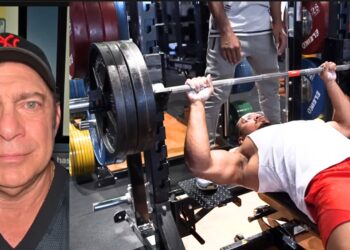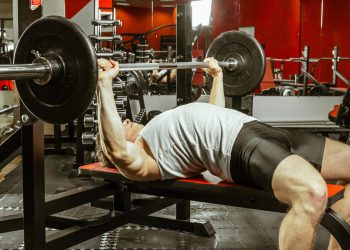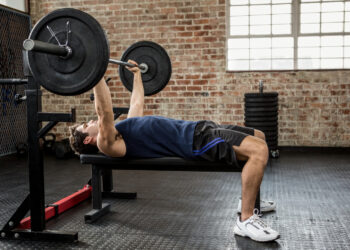The bench press is one of the most popular bodybuilding and strength-building exercises around. It’s good for developing bigger pecs, and it’s one of the events contested in powerlifting. Almost everyone who lifts weights does the bench press.
However, the bench press is also a frustrating exercise. Most people make good initial progress with this lift but then their performance stalls. They get stuck at a particular weight or are unable to do more reps.
Perfecting your bench press technique, bench pressing more often, and doing more sets per workout can all help unstick your bench press. However, while these strategies can be effective, they can also take their toll on your shoulders. As good as the bench press is for building muscle and strength, they can also cause shoulder joint injuries, especially to the fragile rotator cuff.
A rotator cuff is a group of small muscles that stabilize your shoulder joint. Made up of the teres minor, subscapularis, supraspinatus, and infraspinatus, lots of bench pressing can cause these muscles and their tendons to become damaged and inflamed. Rotator cuff problems often take a long time to heal, during which almost all upper body exercises are off the table.
The good news is that there is an exercise that you can do that will boost your bench press performance while giving your shoulders a much-needed break. That exercise is the floor press.
What are floor presses?
The floor press is a low-tech version of the bench press where the exerciser lies on the ground instead of on a bench. This offers several advantages and benefits, which we’ll discuss later.
Level Up Your Fitness: Join our 💪 strong community in Fitness Volt Newsletter. Get daily inspiration, expert-backed workouts, nutrition tips, the latest in strength sports, and the support you need to reach your goals. Subscribe for free!
To do the floor press:
- Set up a squat rack so that the J-hooks are set to about knee height. Place a barbell on the hooks.
- Lie down on the floor so that your eyes are directly beneath the bar. Bend your legs and place your feet on the floor or straighten your legs as preferred.
- Grip the bar with an overhand, slightly wider than shoulder-width grip. Pull your shoulders back and down and press your upper back into the floor. This will increase shoulder stability.
- Unrack the bar and hold the weight with your arms straight. Inhale, bend your arms, and lower the bar down until the back of your upper arms lightly touch the floor.
- Without bouncing, forcefully extend your arms and push the weight back up to arms’ length. Continue until you have completed all the required reps. On completion, carefully re-rack the bar.
Note: Make sure you always have a spotter on hand for this exercise. A failed rep, where you are unable to complete the lift or re-rack the weight, could result in serious injury.
Also read, what you need to know about the Bench Press.
The benefits of floor press and muscles worked
The floor press predates the bench press by many years. The bench press only became popular in the middle of the last century. Before that, if you wanted to do supine (lying on your back) barbell or dumbbell presses, you did them on the floor. However, the floor press is much more than just an old-fashioned exercise. It also offers several benefits, and that includes boosting your bench press performance.
The floor press works the same muscles as the bench press. Those muscles are:
- Pectoralis major– pecs for short, these are the large muscles on the front of your chest.
- Anterior deltoids– the frontmost of the three deltoid or shoulder muscles.
- Triceps brachii– the main muscles on the back of your upper arm, these muscles are usually known simply as the triceps.
The benefits include:
Less shoulder joint stress– lowering the barbell to touch your chest involves a large range of motion, and that can put a lot of pressure on your shoulders. This stress is even worse for exercisers with long arms.
In contrast, floor presses involve a much shorter range of motion, and that reduces wear and tear on the shoulder joint. On the downside, the shortened range of motion means that floor presses as not as good for building chest muscle size as regular barbell or dumbbell bench presses.
Strengthen your lockout– most bench press reps fail at the lockout. This is where you fully straighten your elbows. Floor presses emphasize the triceps so that what was once a weak link becomes a strong one. Floor presses are great for both triceps strength and size.
Level Up Your Fitness: Join our 💪 strong community in Fitness Volt Newsletter. Get daily inspiration, expert-backed workouts, nutrition tips, the latest in strength sports, and the support you need to reach your goals. Subscribe for free!
Break bad bench press habits– a lot of bench pressers lower the bar very quickly and then bounce it off their chests. While this habit may allow you to lift more weight, it takes work away from the target muscles and could lead to serious injury. Floor presses stop you dropping the bar too quickly.
Exercise variety– as good as the bench press is, it’s not the only barbell chest exercise you can do. In fact, if you overuse the bench press, your body will get used to it, and it will cease being such a productive exercise. Switching from bench presses to floor presses will provide you with a break from bench pressing while giving your muscles a novel training stimulus that should help restart your progress.
If you want to increase your bench press performance and are tempted to bench twice a week, considering making the floor press the cornerstone of one of those workouts. This will help reduce your risk of developing overuse injuries, such as tendonitis. For example:
| Monday | Thursday | |||
| Exercise | Sets/reps | Exercise | Sets/reps | |
| 1 | Bench press | 5 sets of five | Floor press | 4 sets of 6 |
| 2 | Inc. dumbbell press | 3 sets of 10 | Cable flyes | 3 sets of 15 |
| 3 | Dips | 3 sets of AMRAP* | Dec. dumbbell press | 3 sets of 10 |
| 4 | Dumbbell flys | 3 sets of 15 | Push-ups | 3 sets of AMRAP* |
*AMRAP – as many reps as possible
Floor press variations
For most exercisers, the floor press provides an excellent way to boost bench press performance while taking the stress off the shoulders. However, once you’ve mastered the basic version of this exercise, there are a few different variations you can use to spice up your workouts.
Narrow grip floor presses
Standard floor presses are a very useful triceps exercise. Make them even more beneficial by adopting a shoulder-width grip and keeping your elbows close to your sides. Expect to have tired, sore triceps after doing this exercise for the first time.
Floor press bridge
This floor press variation involves lifting your hips off the floor. This puts your body at the same angle as a decline bench press. As an added benefit, floor press bridges also work your hamstrings, glutes, and lower back.
- Set up for the floor press as usual and unrack the bar.
- Push your feet into the floor and lift your hips up. Your knees, hips, and shoulders should form a straight line.
- Keep your hips up, bend your arms, and lower the bar down until your elbows lightly touch the ground. Push the bar back up and repeat.
- Keep your hips elevated throughout.
You can do this exercise with a barbell or dumbbells.
Dumbbell floor press
Using dumbbells instead of barbells tests and develops your balance and coordination. It takes a lot of skill to lower both weights at exactly the same speed so that your elbows touch the floor at the same time. If you have a tendency to push more with one arm than the other, this exercise is the cure. Start light; this is a tricky exercise.
Alternating arm dumbbell floor press
As above but using an alternating arm action. Start with both arms straight, or both arms bent as preferred.
Single-arm floor presses
Single-arm floor presses increase core activation, especially in your obliques or waist muscles. Working one side at a time forces all the weight onto one side of your body. You’ll have to use your obliques and legs to stop you from rolling toward the load. If you want to work your upper body and core at the same time, single-arm floor presses are a great choice.
In addition, you can do this exercise without a squat rack or even a spotter. You can use your free hand to help you get the weight into position and to get you out of trouble if you are unable to complete a rep. Do this exercise with a single dumbbell or kettlebell as preferred.
Conclusion
If you want to build a bigger bench press, whether it’s for muscle size or strength, the floor press can help. It can help fix the weak links that are limiting your bench press performance and could even help you avoid injury. Don’t write this exercise off simply because it’s old fashioned and low tech; it’s been around for hundreds of years, and that means it works!








